Papers by Joseane Biso de Carvalho
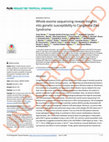
PLOS Neglected Tropical Diseases, 2021
Congenital Zika Syndrome (CZS) is a critical illness with a wide range of severity caused by Zika... more Congenital Zika Syndrome (CZS) is a critical illness with a wide range of severity caused by Zika virus (ZIKV) infection during pregnancy. Life-threatening neurodevelopmental dysfunctions are among the most common phenotypes observed in affected newborns. Risk factors that contribute to susceptibility and response to ZIKV infection may be related to the virus itself, the environment, and maternal genetic background. Nevertheless, the newborn’s genetic contribution to the critical illness is still not elucidated. Here, we aimed to identify possible genetic variants as well as relevant biological pathways that might be associated with CZS phenotypes. For this purpose, we performed a whole-exome sequencing in 40 children born to women with confirmed exposure to ZIKV during pregnancy. We investigated the occurrence of rare harmful single-nucleotide variants (SNVs) possibly associated with inborn errors in genes ontologically related to CZS phenotypes. Moreover, an exome-wide association...
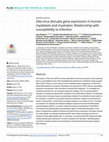
PLOS Neglected Tropical Diseases, 2022
The tropism of Zika virus (ZIKV) has been described in the nervous system, blood, placenta, thymu... more The tropism of Zika virus (ZIKV) has been described in the nervous system, blood, placenta, thymus, and skeletal muscle. We investigated the mechanisms of skeletal muscle susceptibility to ZIKV using an in vitro model of human skeletal muscle myogenesis, in which myoblasts differentiate into myotubes. Myoblasts were permissive to ZIKV infection, generating productive viral particles, while myotubes controlled ZIKV replication. To investigate the underlying mechanisms, we used gene expression profiling. First, we assessed gene changes in myotubes compared with myoblasts in the model without infection. As expected, we observed an increase in genes and pathways related to the contractile muscle system in the myotubes, a reduction in processes linked to proliferation, migration and cytokine production, among others, confirming the myogenic capacity of our system in vitro. A comparison between non-infected and infected myoblasts revealed more than 500 differentially expressed genes (DEGs...

A large number of small RNAs unrelated to the soybean genome were identified after deep sequencin... more A large number of small RNAs unrelated to the soybean genome were identified after deep sequencing of soybean small RNA libraries. A metatranscriptomic analysis was carried out to identify the origin of these sequences. Com-parative analyses of small interference RNAs (siRNAs) present in samples collected in open areas corresponding to soybean field plantations and samples from soybean cultivated in greenhouses under a controlled environment were made. Different pathogenic, symbiotic and free-living organisms were identified from samples of both growth sys-tems. They included viruses, bacteria and different groups of fungi. This approach can be useful not only to identify potentially unknown pathogens and pests, but also to understand the relations that soybean plants establish with mi-croorganisms that may affect, directly or indirectly, plant health and crop production. Key words: next generation sequencing, small RNA, siRNA, molecular markers.
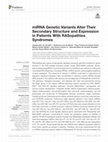
Frontiers in Genetics, 2019
RASopathies are a group of rare genetic diseases caused by germline mutations in genes involved i... more RASopathies are a group of rare genetic diseases caused by germline mutations in genes involved in the RAS–mitogen-activated protein kinase (RAS-MAPK) pathway. Whole-exome sequencing (WES) is a powerful approach for identifying new variants in coding and noncoding DNA sequences, including miRNAs. miRNAs are fine-tuning negative regulators of gene expression. The presence of variants in miRNAs could lead to malfunctions of regulation, resulting in diseases. Here, we identified 41 variants in mature miRNAs through WES analysis in five patients with previous clinical diagnosis of RASopathies syndromes. The pathways, biological processes, and diseases that were over-represented among the target genes of the mature miRNAs harboring variants included the RAS, MAPK, RAP1, and PIK3-Akt signaling pathways, neuronal differentiation, neurogenesis and nervous system development, congenital cardiac defects (hypertrophic cardiomyopathy, dilated cardiomyopathy, and arrhythmogenic right ventricular...
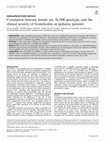
Background Single-nucleotide polymorphisms (SNPs) that impact on the differential expression of i... more Background Single-nucleotide polymorphisms (SNPs) that impact on the differential expression of interleukin 28B (IL28B) are implicated in the progression of viral-induced diseases. In this prospective longitudinal cohort study, we evaluated the association between IL28B SNPs rs12979860 and rs8099917 and the clinical outcome of bronchiolitis in pediatric patients. Methods A total of 682 infants suffering from bronchiolitis, categorized based on the final clinical outcome as mild or severe, were genotyped for IL28B SNPs rs12979860 and rs8099917. Results When infants were categorized exclusively based on the final clinical outcome, no association was established between IL28B SNPs and the severity of bronchiolitis. However, when stratified by sex, the homozygotes for the minor alleles of rs12979860 (T) and rs8099917 (G) were associated with a mild disease in girls but not in boys. Conclusion SNPs rs12979860 and rs8099917 correlate with the severity of bronchiolitis and display a sex bi...

Plant and Soil
Iron toxicity is a major nutritional disorder in rice plants, especially in flooded areas. The us... more Iron toxicity is a major nutritional disorder in rice plants, especially in flooded areas. The use of alternative crop management practices, such as soil drainage, may mitigate negative impacts of iron toxicity, since soil aeration that follows drainage can oxidize and precipitate potentially toxic Fe+2 into Fe3+. This study aimed to evaluate the impact of alternative water management on agronomical and physiological parameters in rice plants grown in a field location with iron toxicity history. Rice cultivars BR-IRGA 409 (sensitive) and IRGA 425 (resistant to iron toxicity) were tested. Irrigation management comprised three treatments: Continuous Irrigation (CI), one cycle of water Suppression (1S) and two cycles of water Suppression (2S). Evaluations included the ionic composition of soil solution and leaf tissues, grain yield, antioxidant responses and gene expression. Permanent soil flooding resulted in higher grain yield in plants from the resistant than from the sensitive genotype, which had higher malondialdehyde (MDA) concentrations in leaves. In contrast, two cycles of alternate soil drying resulted in equivalent grain yield and MDA concentrations in both genotypes. Resistance to iron toxicity in IRGA 425 plants seems related to limited Fe translocation to shoots, increased tolerance to oxidative stress in leaves and higher expression of Ferritin, OsGAP1, OsWRKY80 and Oryzain-α genes. Plants from the BR-IRGA 409 cultivar (sensitive to Fe toxicity) improved growth and yield under the interrupted irrigation treatments, probably due to lower Fe availability in the soil solution. Management of water irrigation successfully alleviated Fe toxicity in rice plants cultivated in field conditions.
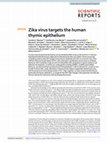
Scientific Reports
Previous work showed that the thymus can be infected by RNA viruses as HIV and HTLV-1. We thus hy... more Previous work showed that the thymus can be infected by RNA viruses as HIV and HTLV-1. We thus hypothesized that the thymus might also be infected by the Zika virus (ZIKV). Herein we provide compelling evidence that ZIKV targets human thymic epithelial cells (TEC) in vivo and in vitro. ZIKV-infection enhances keratinization of TEC, with a decrease in proliferation and increase in cell death. Moreover, ZIKV modulates a high amount of coding RNAs with upregulation of genes related to cell adhesion and migration, as well as non-coding genes including miRNAs, circRNAs and lncRNAs. Moreover, we observed enhanced attachment of lymphoblastic T-cells to infected TEC, as well as virus transfer to those cells. Lastly, alterations in thymuses from babies congenitally infected were seen, with the presence of viral envelope protein in TEC. Taken together, our data reveals that the thymus, particularly the thymic epithelium, is a target for the ZIKV with changes in the expression of molecules tha...

AGRADECIMENTOS À Deus, por me oferecer mais essa oportunidade na vida, sem Ele seria difícil cump... more AGRADECIMENTOS À Deus, por me oferecer mais essa oportunidade na vida, sem Ele seria difícil cumprir mais essa etapa. À minha mãe Anecy B. de Carvalho e irmã Alexandra B. de Carvalho, pelo apoio, compreensão pela minha ausência e motivação para a realização de todo o trabalho. Ao meu pai, Manoel (in memorian), que sempre me apoiou em todos os meus ideais e sempre estará presente em minha vida. Ao meu namorado Guilherme, pelo apoio, compreensão e motivação em todos os momentos. À minha sogra, Reusa Loss, pelo ombro amigo nos momentos difíceis. Ao professor Valmir Duarte, pela orientação, conselhos e ensinamentos transmitidos ao longo dessa jornada. iii Ao professor Rogério Margis, pelo auxílio, orientação e grande contribuição para que esse trabalho fosse realizado. Aos demais professores, pelos ensinamentos transmitidos ao longo do doutorado. Aos funcionários do Departamento de Fitossanidade, pela amizade e colaboração. Aos colegas da Fitossanidade, Adriana A. Figueiró, Isabel P. Paz, Cátia Rommel, Felipe A. S. Graichen pela amizade, incentivo e apoio nos momentos mais difíceis.
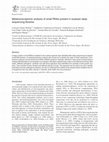
Genet Mol Biol, 2012
A large number of small RNAs unrelated to the soybean genome were identified after deep sequencin... more A large number of small RNAs unrelated to the soybean genome were identified after deep sequencing of soybean small RNA libraries. A metatranscriptomic analysis was carried out to identify the origin of these sequences. Comparative analyses of small interference RNAs (siRNAs) present in samples collected in open areas corresponding to soybean field plantations and samples from soybean cultivated in greenhouses under a controlled environment were made. Different pathogenic, symbiotic and free-living organisms were identified from samples of both growth systems. They included viruses, bacteria and different groups of fungi. This approach can be useful not only to identify potentially unknown pathogens and pests, but also to understand the relations that soybean plants establish with microorganisms that may affect, directly or indirectly, plant health and crop production.

Uploads
Papers by Joseane Biso de Carvalho